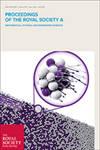Nanocrystalline ceria imparts better high–temperature protection
Proceedings of the Royal Society of London. Series A. Mathematical and Physical Sciences
Pub Date : 2004-12-08
DOI:10.1098/rspa.2004.1352
引用次数: 54
Abstract
Nanomaterials have attracted considerable interest with numerous technological developments in the last decade. Nanomaterials exhibit different physicochemical properties compared with their bulk counterparts because the diameters of the nanoparticles are less than the Bohr exciton radius. Cerium oxide based materials have been extensively studied for various technological applications. In the present study, the application of nanocrystalline cerium oxide for improvement of high–temperature–oxidation resistance of stainless steel has been studied. The role of coating of nanocrystalline cerium oxide towards improvement of high–temperature–oxidation resistance has been investigated and compared with that of the micrometre–sized cerium oxide particles. It was observed that nanocrystalline ceria improved high–temperature–oxidation resistance of AISI 304 stainless steel to a large extent compared with the micrometre–sized ceria coating. Nanocrystalline ceria coating decreased the isothermal parabolic rate constant of oxidation by more than two orders of magnitude compared with that of the bare alloy. The resistance to oxide scale spallation was also found to improve with the coating of cerium oxide nanoparticles. Secondary ion mass spectroscopy (SIMS) study of nanocrystalline ceria–coated and oxidized specimens revealed the presence of nanoceria at the outermost oxide surface, indicating a change in the oxide scale growth mechanism from outward cation diffusion to inward oxygen diffusion in the bare alloy at high temperature in dry air. The oxide scale morphology was studied using a scanning electron microscope (SEM) while a focused ion beam (FIB) technique was used to study the oxide–alloy interface. X–ray photoelectron spectroscopy (XPS) study of nanocrystalline ceria showed the presence of Ce3+ and Ce4+ oxidation states. It is proposed that the presence of the Ce3+ oxidation state in nanocrystalline ceria improves the oxidation resistance of stainless steel, and the related mechanisms are discussed.纳米晶二氧化铈提供更好的高温保护
在过去的十年中,随着技术的发展,纳米材料引起了人们的极大兴趣。由于纳米粒子的直径小于玻尔激子半径,纳米材料表现出不同于块状材料的物理化学性质。氧化铈基材料在各种技术应用方面得到了广泛的研究。本文研究了纳米晶氧化铈在提高不锈钢耐高温氧化性能中的应用。研究了纳米氧化铈涂层对提高其耐高温氧化性能的作用,并与微米级氧化铈涂层进行了比较。结果表明,纳米晶氧化铈与微米级氧化铈涂层相比,在很大程度上提高了AISI 304不锈钢的耐高温氧化性能。纳米晶氧化铈涂层使氧化等温抛物线速率常数比裸合金降低了两个数量级以上。纳米氧化铈涂层也提高了材料抗氧化垢剥落的能力。通过二次离子质谱(SIMS)研究纳米晶氧化铈包覆和氧化试样,发现氧化表面最外层存在纳米铈,表明在干燥空气高温下,裸露合金中氧化垢的生长机制由向外的阳离子扩散转变为向内的氧扩散。利用扫描电子显微镜(SEM)研究了氧化膜的形貌,利用聚焦离子束(FIB)技术研究了氧化膜与合金界面的形貌。x射线光电子能谱(XPS)研究表明纳米晶铈存在Ce3+和Ce4+氧化态。提出纳米晶铈中Ce3+氧化态的存在提高了不锈钢的抗氧化性,并讨论了相关机理。
本文章由计算机程序翻译,如有差异,请以英文原文为准。
求助全文
约1分钟内获得全文
求助全文
来源期刊
自引率
0.00%
发文量
0
期刊介绍:
Proceedings A publishes articles across the chemical, computational, Earth, engineering, mathematical, and physical sciences. The articles published are high-quality, original, fundamental articles of interest to a wide range of scientists, and often have long citation half-lives. As well as established disciplines, we encourage emerging and interdisciplinary areas.

 求助内容:
求助内容: 应助结果提醒方式:
应助结果提醒方式:


